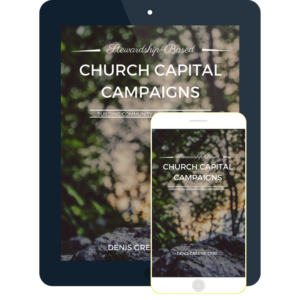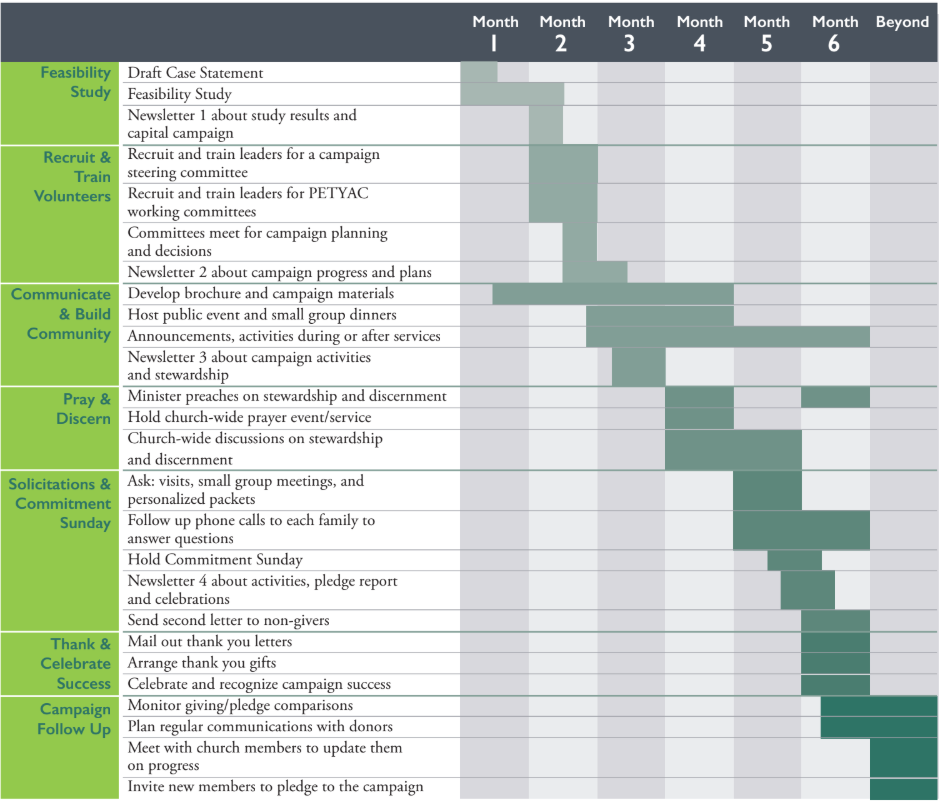Above is a sample church capital campaign calendar for organizing your activities. Our capital campaign process is tailored for each individual church to best fit the needs of the culture of your community. We don’t believe in one-size fits all campaigns but instead work with your leadership team to make sure the components of the campaign are timed well to be received by the volunteers and congregation.
Month 1
Pre-Campaign Feasibility Study
A feasibility study is crucial for a few reasons including building support for the upcoming campaign and, very practically, helping to set the campaign financial goal. As you’re getting started with a church capital campaign, this first step of the process involves leadership in personal interviews and solicits feedback from the community as a whole. Specific tasks to be completed include:
- Draft the campaign case statement and survey instruments
- Interview key church leaders
- Survey all church members
- Prepare and present final report to church leaders.
- Distribute newsletter with case statement, feasibility study results and campaign information
- (Note: If you decide to do some research on potential top donors, you should do it here)
Month 2
Organize and Train Campaign Volunteers
Once your goal is clear and you’ve primped your members for an upcoming fundraising project, you want to do everything you can to get people involved early. Soliciting, organizing and training volunteers on specific campaign-related committees will get you moving full steam ahead. Look to accomplish:
- Recruit and train leaders for an executive/management campaign committee
- Recruit and train leaders for the following working campaign committees:
- Prayer
- Youth
- Events
- Ambassadors
- Thanks
- Communications
- Committees meet for campaign planning and decisions
- Distribute newsletter #1 about campaign progress and plans
Month 3
Communicate the Vision, Build Community, Cultivate Stewards
Once your committees are organized and running you’ll want to turn your attention to branding your campaign, providing social opportunities for people to get connected to other members in the church, and educating on the meaning of discipleship and stewardship. These focus areas are supported by your volunteer communication and events committees. Support your teams but give them the freedom to use their creativity in executing the campaign activities! In month 3 look to:
- Host public events and dinners to spread the vision, build community and cultivate stewardship among members
- Invite additional participation through publicity, announcements, activities during or after services and preaching
- Mail newsletter about campaign activities and stewardship
Month 4
Pray and Discern
You should continue to host social events and communicate campaign updates to the congregation but in month 4 the focus shifts to prayer and discernment. Plan to emphasize discipleship or prayer in action, to help people understand that their pledge is part of their prayer life. Invite members to pray about trusting the Lord in making a pledge by:
- Minister preaches on stewardship and discernment
- Church-wide discussions on stewardship and discernment
- Mail campaign prayer, stewardship brochure, and pledge card to each member
Month 5
Solicit Contributions and Commitment Weekend
Many people are surprised to find that it’s not until 5 months into the campaign that we recommend asking for donations. Hopefully you can see the importance of building community support for the campaign in the months prior to asking for contributions. Here is the big moment to watch the pledges roll in!:
- Begin publicly soliciting contributions for Commitment Weekend
- Ask for pledges through personal visits, small group meetings and/or personalized letters
- Host Commitment Weekend
- Follow-up phone calls to each family to answer questions
- Distribute newsletters about campaign activities, pledges and thank you celebrations
- Send second letter to non-givers
Month 6
Thank Contributors and Celebrate Success
While there is great excitement with making it to and through Commitment Sunday, don’t put your feet up just yet. Expressing thanks and following up with families who may have forgotten to pledge is also important! All pledges are a sacrifice in some way, and expressing gratitude honors that sacrifice. Shortly after Commitment Sunday:
- Mail out thank you letters
- Arrange thank you gifts
- Celebrate and recognize campaign success
Campaign Follow Up
Almost there! Think of your campaign like a bonfire. Burn it hot and huge at the beginning, then stoke the coals to prevent it from going out. Keep the long, slow fire burning for your campaign through regularly communicating collected funds and thanking your contributors for the duration of your pledge period (we recommend 3 years). Create a follow up committee to help:
- Monitor giving/pledge comparisons
- Plan regular communications with donors
- Meet with church members to update them on progress
- Invite new members to pledge to the campaign
- Boost your planned giving effort through establishing a legacy society
This can look like an overwhelming amount of work requiring a dedicated person to run the campaign. Unsurprisingly, we highly suggest hiring a professional fundraising consulting firm who is familiar with the spirituality of giving to help organize your campaign process. Check our our recommended interview questions for capital campaign consulting and tips to consider when hiring a fundraising firm for your project. For a more comprehensive guide to running your capital campaign download our ebook.
Download eBook on Church Capital Campaigns



